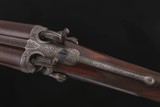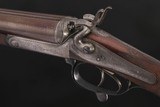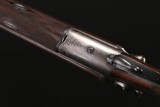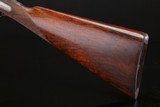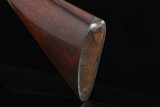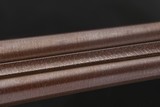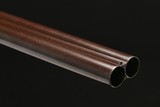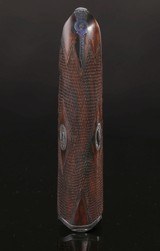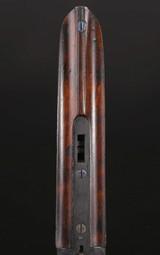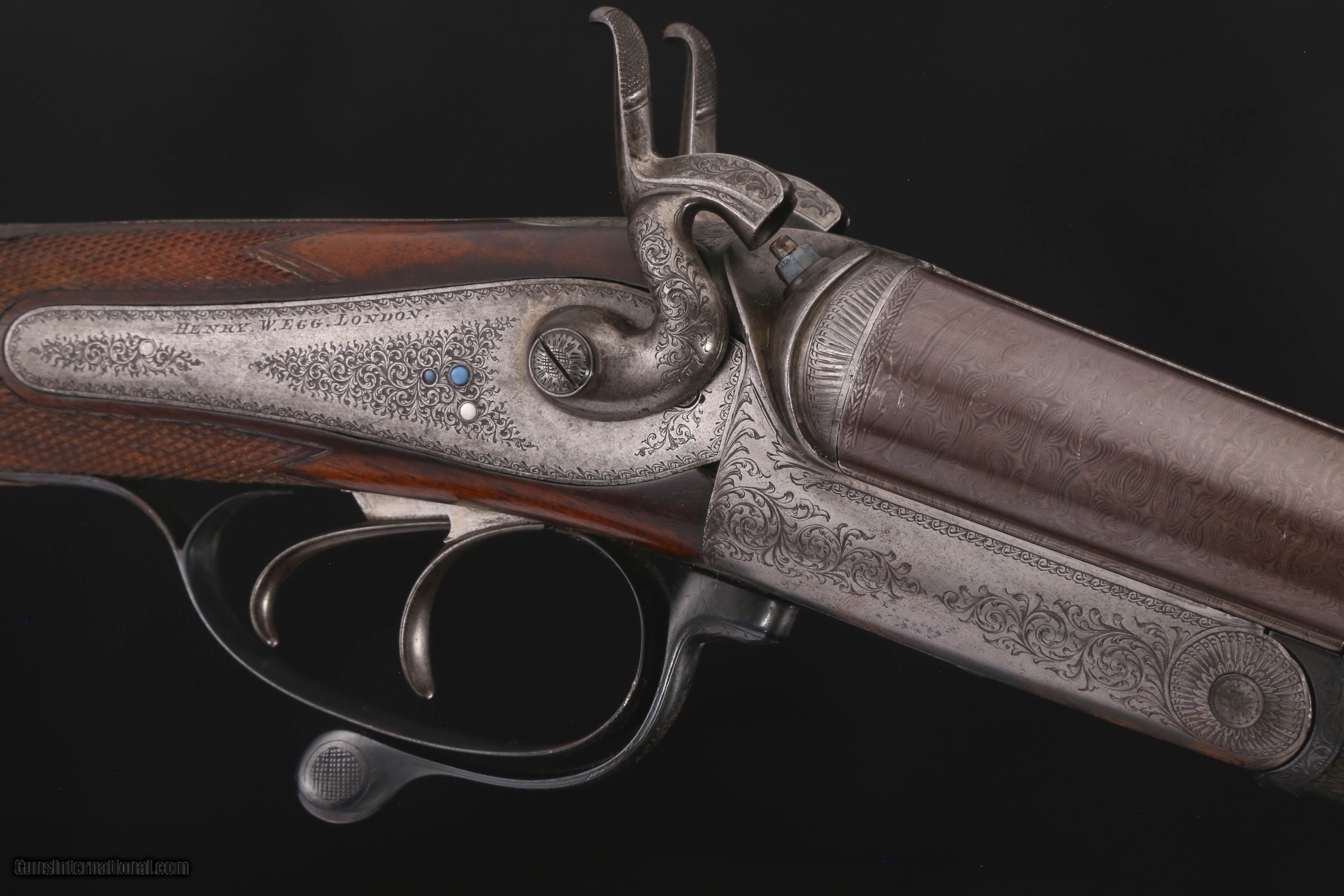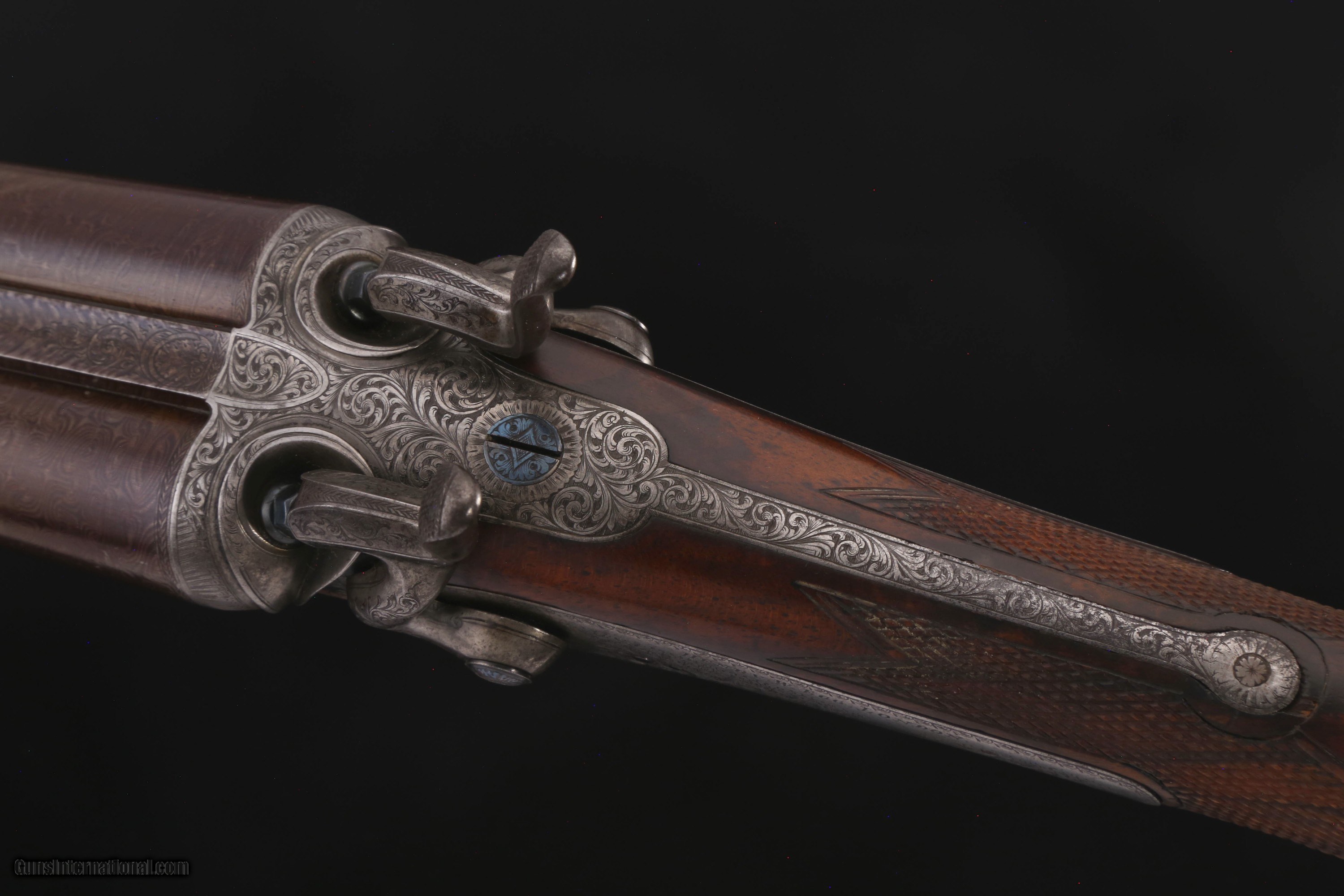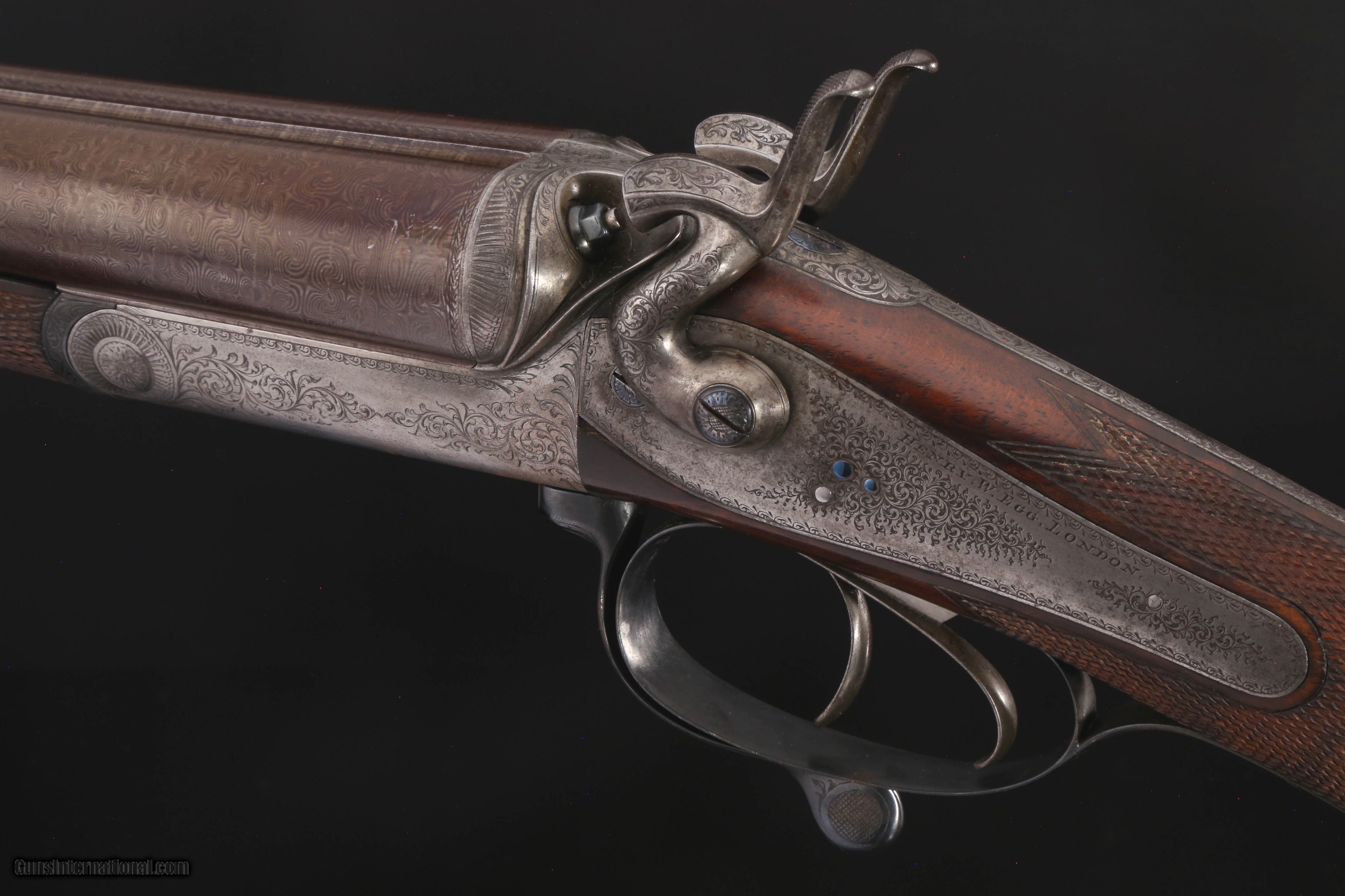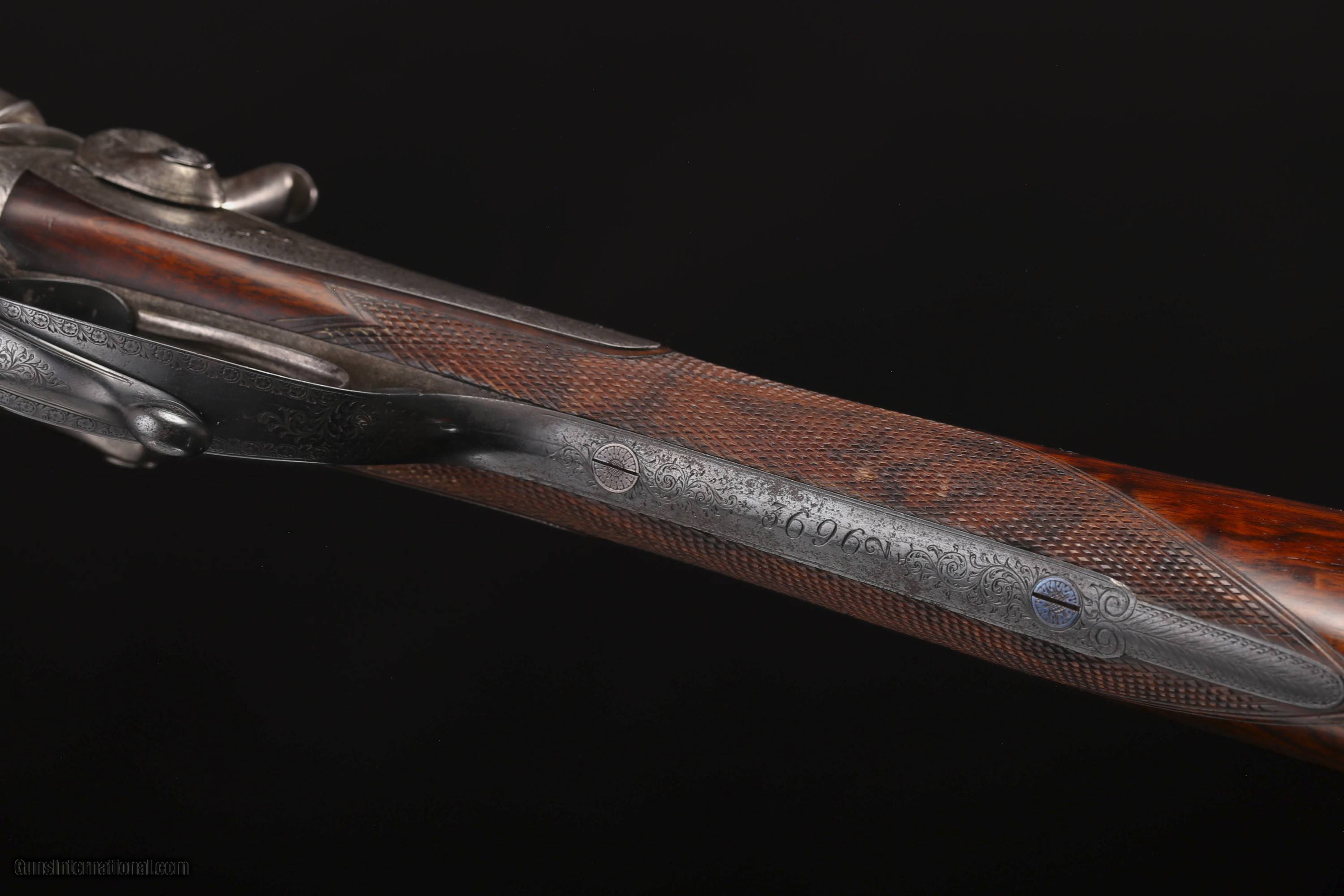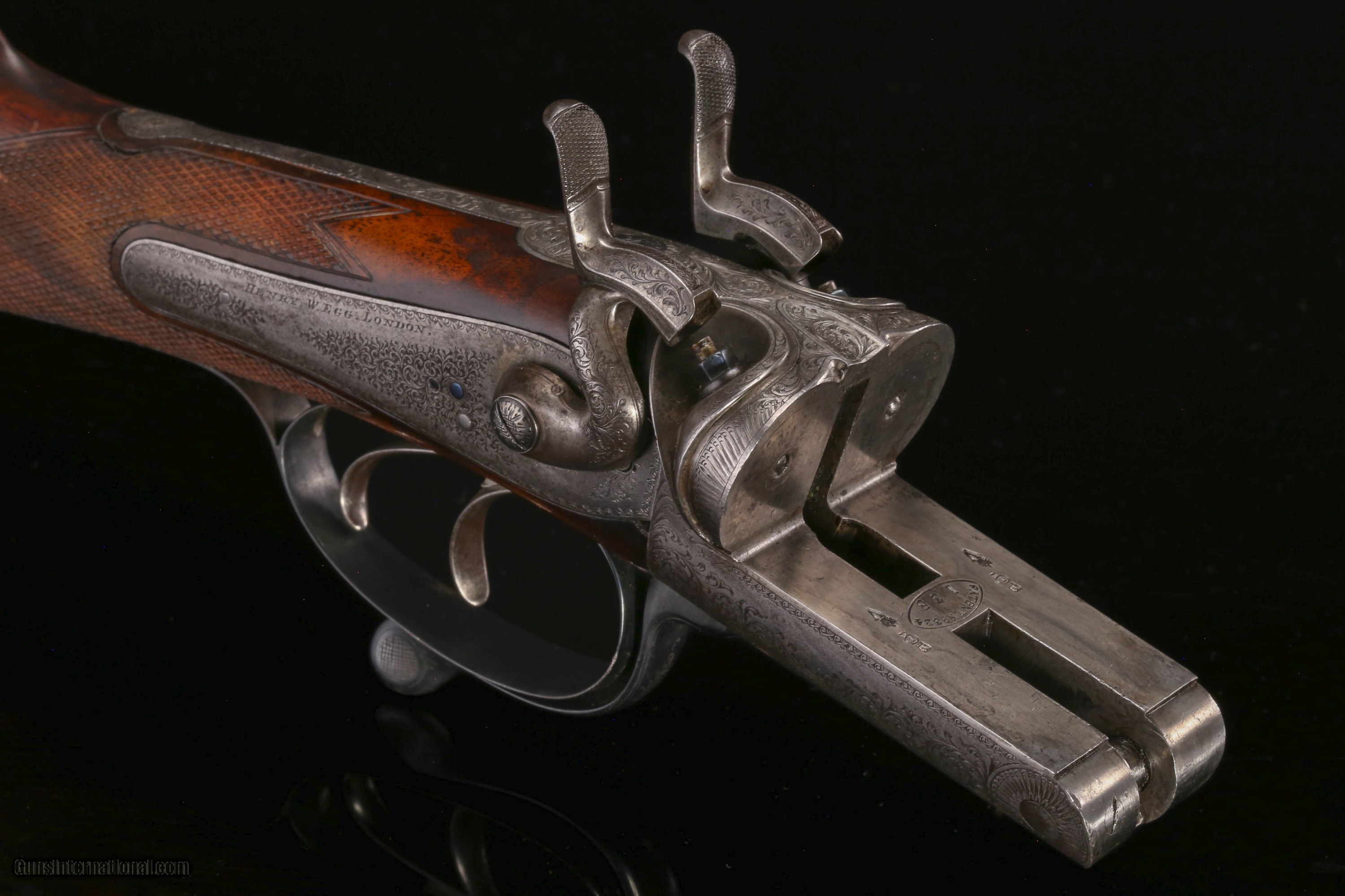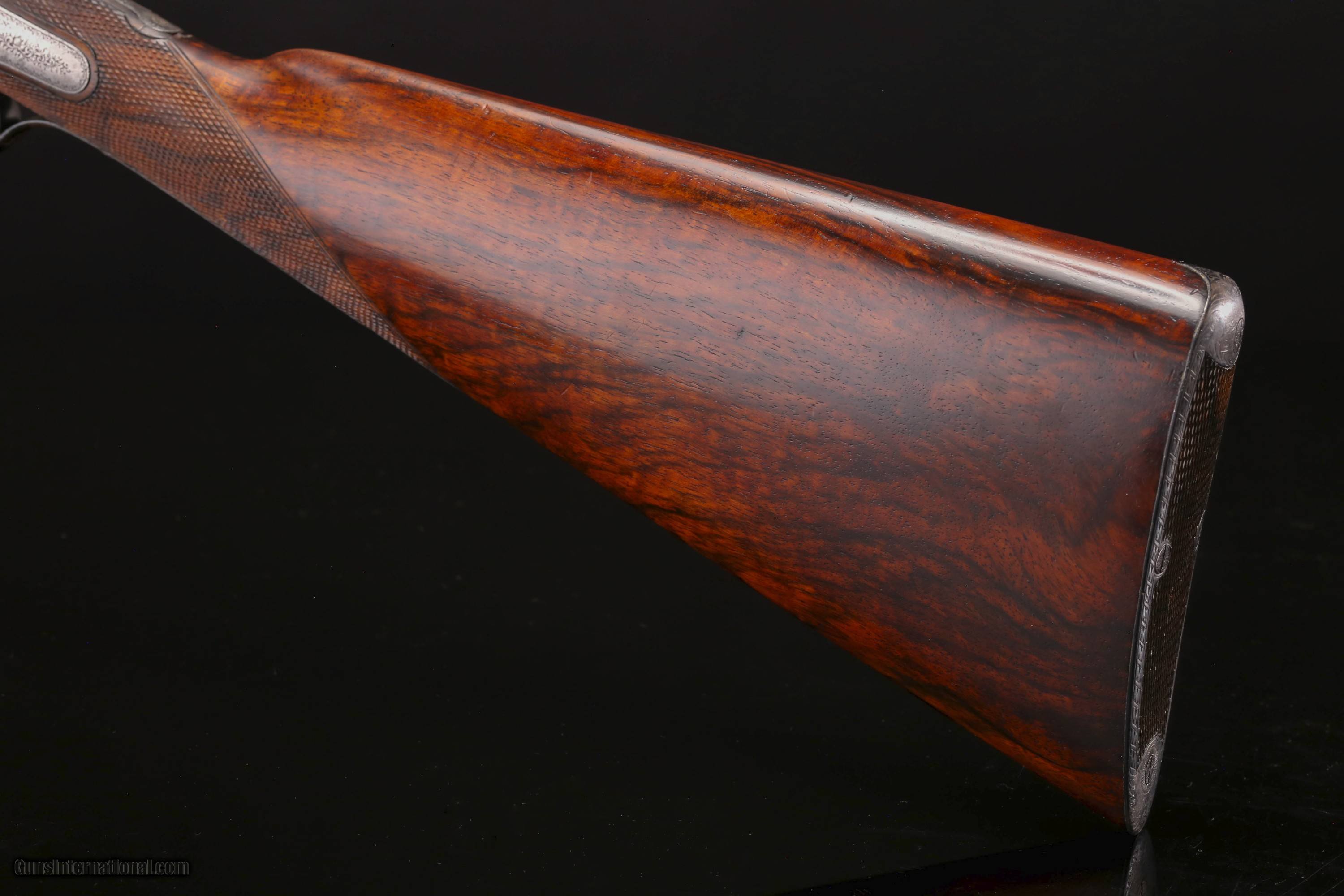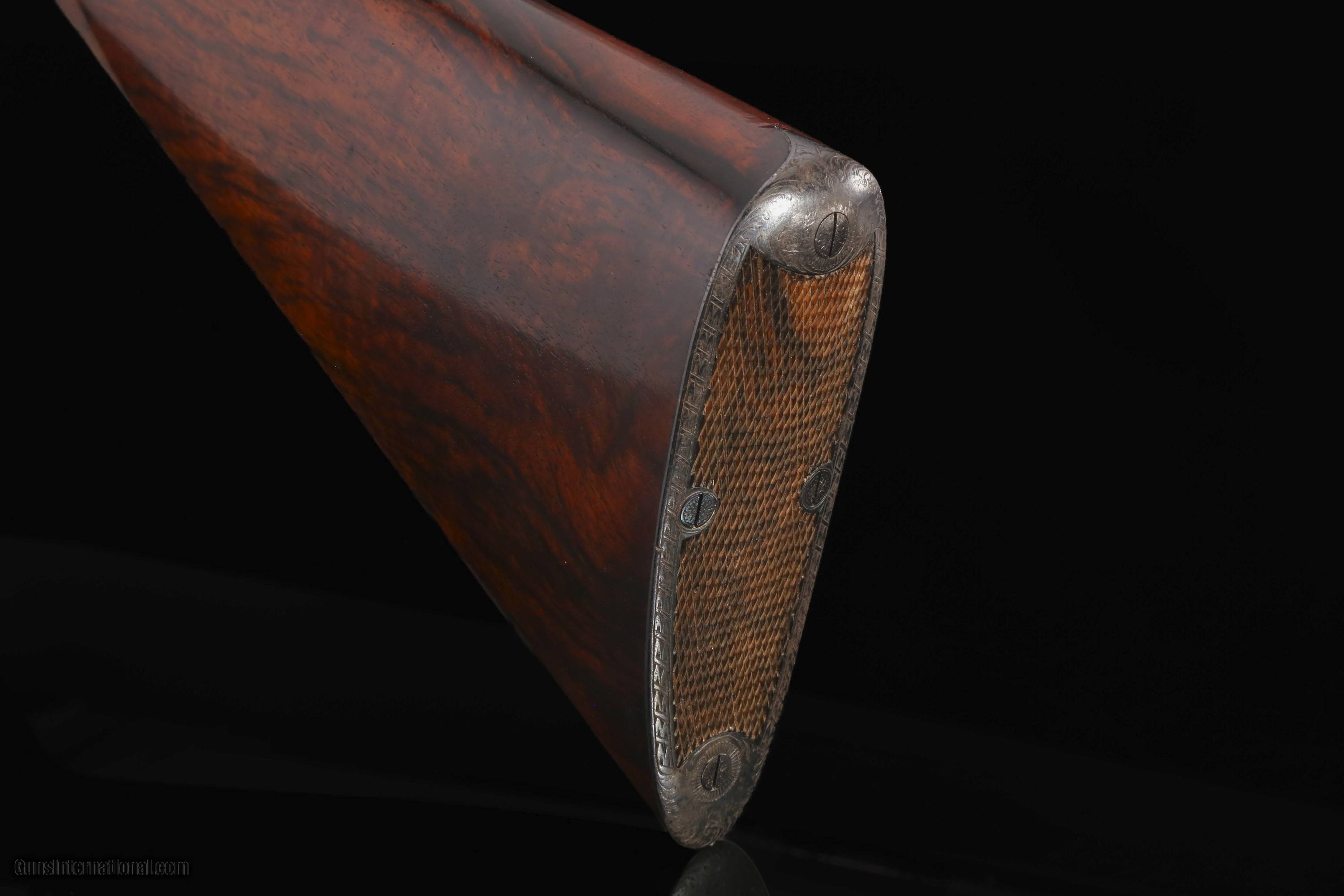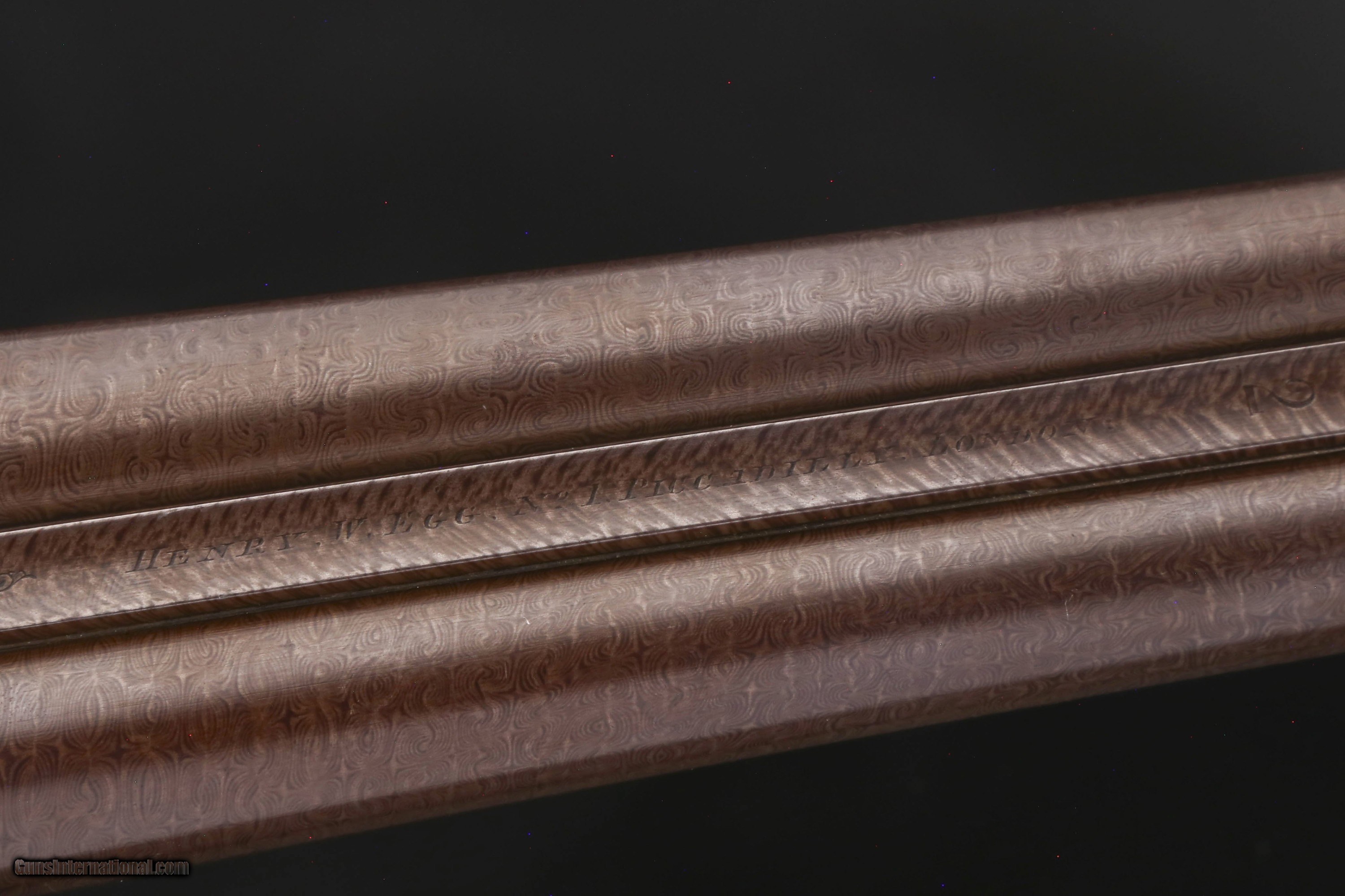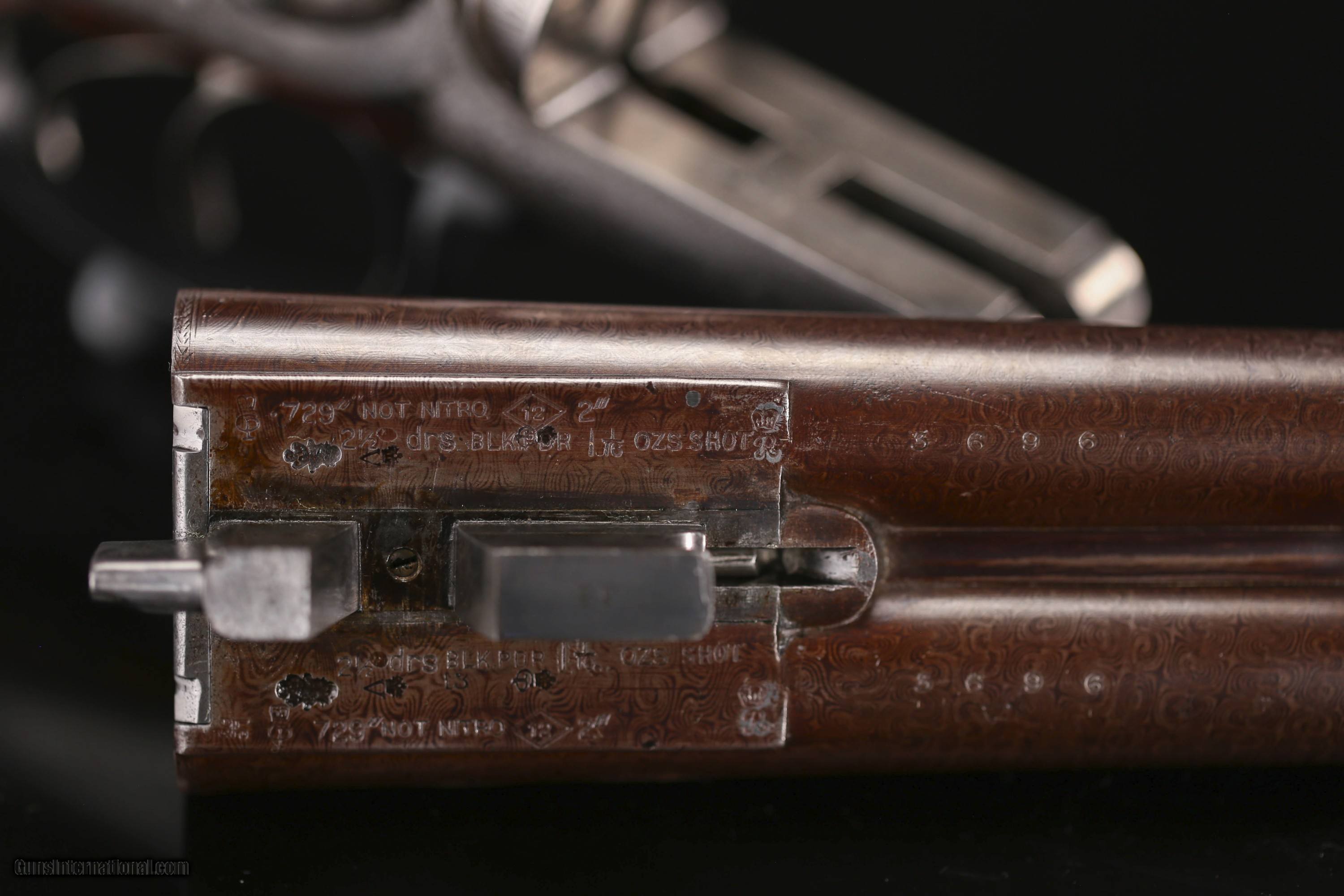Your Session is Ending
 The server has not detected any activity for the last 3 hours.
For your security, your session will expire in 2 minutes and you will be redirected to the Sign In page.
Would you like to stay signed in?
The server has not detected any activity for the last 3 hours.
For your security, your session will expire in 2 minutes and you will be redirected to the Sign In page.
Would you like to stay signed in?
Henry W. Egg 12 Bore “Two Inch” Hammergun | Rare J. Thomas Patent Snap-Action Underlever | Engraved Skeletal Buttplate for sale
Henry W. Egg 12 Bore “Two Inch” Hammergun | Rare J. Thomas Patent Snap-Action Underlever | Engraved Skeletal Buttplate for sale
Guns International #: 103145109
Henry W. Egg 12 Bore “Two Inch” Hammergun | Rare J. Thomas Patent Snap-Action Underlever | Engraved Skeletal Buttplate
Description:
A scarce and mechanically distinctive Henry Egg "two Inch" 12 bore hammergun, built on the J. Thomas snap-action underlever patent No. 324 of 1870. This rare patent is seldom encountered today, and almost never in this configuration—with a rotating snap-action underlever and 2" cambering.
The Thomas design employs a turret set on a vertical axis, visible through a slot cut in the action face. As the barrels are closed, the turret captures a tongue projection on the rear of the back barrel lump—locking the barrels securely in place. While most surviving examples of this patent are found with topelevers, this particular gun is the only rotating underlever version known to have surfaced in the marketplace.
This gun was produced during the tenure of Henry William Egg, who took over his father’s firm in 1869, renaming it under his own name. Born in 1845 in St. James, Egg was listed in the 1871 census as a gunsmith employing seven men, two boys, and one woman. The firm traded until 1880, and its guns reflect a standard of workmanship passed down through the family, who had acquired Joseph Manton’s business in 1839—one of the most prestigious legacies in British gunmaking.
This example features percussion-style fences, rebounding backaction locks, and fine foliate scroll engraving, which remains crisp and clear. The highly figured stock is fitted with an engraved skeletal buttplate, and shows a small chip below the right lock. The Damascus barrels retain a beautiful brown and ring clear, with only a few scattered shallow pits present. The gun is tight on the face, with excellent mechanical function.
A fascinating and possibly unique example from the transitional era of British sporting gun design.
Details:
Date of Manufacture: 1875
FFL Status: Antique
Ejector: No
Weight: 6lb 12oz
Barrel Type: Damascus
Barrel Length: 30"
Chamber Length: 2"
Black Powder Proof: BLK PDR Re-proof .729
Bore Diameter:
Right: .730
Left: .732
Minimum Wall Thickness (Thou):
Right: 26
Left: 22
Choke:
Right: .000
Left: .000
Stock Dimensions
LOP: 14 3/8" to Skeletal Buttplace
DOC: 1 3/4"
DOH: 2 11/16"
Cast: Neutral
Free standard shipping with free returns
Antique: Yes
Shotgun Gauge: 12 Gauge
Manufacturer: Henry W. Egg
Serial Number: 3696
Barrel Length: 30
Chambers: 2
Barrels: Damascus
Stock Comb: 1 3/4
Stock Heel: 2 11/16
Stock Cast: neutral
LOP: 14 3/8
Weight: 6lb 12oz
Choke Left: .000 cyl
Choke Right: .000 cly
Proof:Black: Black Re-proof .729
Minimum Wall Thickness Left: 22 Thou
Minimum Wall Thickness Right: 26 Thou
Price: $2,900.00
Description:
A scarce and mechanically distinctive Henry Egg "two Inch" 12 bore hammergun, built on the J. Thomas snap-action underlever patent No. 324 of 1870. This rare patent is seldom encountered today, and almost never in this configuration—with a rotating snap-action underlever and 2" cambering.
The Thomas design employs a turret set on a vertical axis, visible through a slot cut in the action face. As the barrels are closed, the turret captures a tongue projection on the rear of the back barrel lump—locking the barrels securely in place. While most surviving examples of this patent are found with topelevers, this particular gun is the only rotating underlever version known to have surfaced in the marketplace.
This gun was produced during the tenure of Henry William Egg, who took over his father’s firm in 1869, renaming it under his own name. Born in 1845 in St. James, Egg was listed in the 1871 census as a gunsmith employing seven men, two boys, and one woman. The firm traded until 1880, and its guns reflect a standard of workmanship passed down through the family, who had acquired Joseph Manton’s business in 1839—one of the most prestigious legacies in British gunmaking.
This example features percussion-style fences, rebounding backaction locks, and fine foliate scroll engraving, which remains crisp and clear. The highly figured stock is fitted with an engraved skeletal buttplate, and shows a small chip below the right lock. The Damascus barrels retain a beautiful brown and ring clear, with only a few scattered shallow pits present. The gun is tight on the face, with excellent mechanical function.
A fascinating and possibly unique example from the transitional era of British sporting gun design.
Details:
Date of Manufacture: 1875
FFL Status: Antique
Ejector: No
Weight: 6lb 12oz
Barrel Type: Damascus
Barrel Length: 30"
Chamber Length: 2"
Black Powder Proof: BLK PDR Re-proof .729
Bore Diameter:
Right: .730
Left: .732
Minimum Wall Thickness (Thou):
Right: 26
Left: 22
Choke:
Right: .000
Left: .000
Stock Dimensions
LOP: 14 3/8" to Skeletal Buttplace
DOC: 1 3/4"
DOH: 2 11/16"
Cast: Neutral
Free standard shipping with free returns
Antique: Yes
Shotgun Gauge: 12 Gauge
Manufacturer: Henry W. Egg
Serial Number: 3696
Barrel Length: 30
Chambers: 2
Barrels: Damascus
Stock Comb: 1 3/4
Stock Heel: 2 11/16
Stock Cast: neutral
LOP: 14 3/8
Weight: 6lb 12oz
Choke Left: .000 cyl
Choke Right: .000 cly
Proof:Black: Black Re-proof .729
Minimum Wall Thickness Left: 22 Thou
Minimum Wall Thickness Right: 26 Thou
Price: $2,900.00
Contact Seller
Guns International #: 103145109
Henry W. Egg 12 Bore “Two Inch” Hammergun | Rare J. Thomas Patent Snap-Action Underlever | Engraved Skeletal Buttplate
Description:
A scarce and mechanically distinctive Henry Egg "two Inch" 12 bore hammergun, built on the J. Thomas snap-action underlever patent No. 324 of 1870. This rare patent is seldom encountered today, and almost never in this configuration—with a rotating snap-action underlever and 2" cambering.
The Thomas design employs a turret set on a vertical axis, visible through a slot cut in the action face. As the barrels are closed, the turret captures a tongue projection on the rear of the back barrel lump—locking the barrels securely in place. While most surviving examples of this patent are found with topelevers, this particular gun is the only rotating underlever version known to have surfaced in the marketplace.
This gun was produced during the tenure of Henry William Egg, who took over his father’s firm in 1869, renaming it under his own name. Born in 1845 in St. James, Egg was listed in the 1871 census as a gunsmith employing seven men, two boys, and one woman. The firm traded until 1880, and its guns reflect a standard of workmanship passed down through the family, who had acquired Joseph Manton’s business in 1839—one of the most prestigious legacies in British gunmaking.
This example features percussion-style fences, rebounding backaction locks, and fine foliate scroll engraving, which remains crisp and clear. The highly figured stock is fitted with an engraved skeletal buttplate, and shows a small chip below the right lock. The Damascus barrels retain a beautiful brown and ring clear, with only a few scattered shallow pits present. The gun is tight on the face, with excellent mechanical function.
A fascinating and possibly unique example from the transitional era of British sporting gun design.
Details:
Date of Manufacture: 1875
FFL Status: Antique
Ejector: No
Weight: 6lb 12oz
Barrel Type: Damascus
Barrel Length: 30"
Chamber Length: 2"
Black Powder Proof: BLK PDR Re-proof .729
Bore Diameter:
Right: .730
Left: .732
Minimum Wall Thickness (Thou):
Right: 26
Left: 22
Choke:
Right: .000
Left: .000
Stock Dimensions
LOP: 14 3/8" to Skeletal Buttplace
DOC: 1 3/4"
DOH: 2 11/16"
Cast: Neutral
Free standard shipping with free returns
Antique: Yes
Shotgun Gauge: 12 Gauge
Manufacturer: Henry W. Egg
Serial Number: 3696
Barrel Length: 30
Chambers: 2
Barrels: Damascus
Stock Comb: 1 3/4
Stock Heel: 2 11/16
Stock Cast: neutral
LOP: 14 3/8
Weight: 6lb 12oz
Choke Left: .000 cyl
Choke Right: .000 cly
Proof:Black: Black Re-proof .729
Minimum Wall Thickness Left: 22 Thou
Minimum Wall Thickness Right: 26 Thou
Price: $2,900.00
Description:
A scarce and mechanically distinctive Henry Egg "two Inch" 12 bore hammergun, built on the J. Thomas snap-action underlever patent No. 324 of 1870. This rare patent is seldom encountered today, and almost never in this configuration—with a rotating snap-action underlever and 2" cambering.
The Thomas design employs a turret set on a vertical axis, visible through a slot cut in the action face. As the barrels are closed, the turret captures a tongue projection on the rear of the back barrel lump—locking the barrels securely in place. While most surviving examples of this patent are found with topelevers, this particular gun is the only rotating underlever version known to have surfaced in the marketplace.
This gun was produced during the tenure of Henry William Egg, who took over his father’s firm in 1869, renaming it under his own name. Born in 1845 in St. James, Egg was listed in the 1871 census as a gunsmith employing seven men, two boys, and one woman. The firm traded until 1880, and its guns reflect a standard of workmanship passed down through the family, who had acquired Joseph Manton’s business in 1839—one of the most prestigious legacies in British gunmaking.
This example features percussion-style fences, rebounding backaction locks, and fine foliate scroll engraving, which remains crisp and clear. The highly figured stock is fitted with an engraved skeletal buttplate, and shows a small chip below the right lock. The Damascus barrels retain a beautiful brown and ring clear, with only a few scattered shallow pits present. The gun is tight on the face, with excellent mechanical function.
A fascinating and possibly unique example from the transitional era of British sporting gun design.
Details:
Date of Manufacture: 1875
FFL Status: Antique
Ejector: No
Weight: 6lb 12oz
Barrel Type: Damascus
Barrel Length: 30"
Chamber Length: 2"
Black Powder Proof: BLK PDR Re-proof .729
Bore Diameter:
Right: .730
Left: .732
Minimum Wall Thickness (Thou):
Right: 26
Left: 22
Choke:
Right: .000
Left: .000
Stock Dimensions
LOP: 14 3/8" to Skeletal Buttplace
DOC: 1 3/4"
DOH: 2 11/16"
Cast: Neutral
Free standard shipping with free returns
Antique: Yes
Shotgun Gauge: 12 Gauge
Manufacturer: Henry W. Egg
Serial Number: 3696
Barrel Length: 30
Chambers: 2
Barrels: Damascus
Stock Comb: 1 3/4
Stock Heel: 2 11/16
Stock Cast: neutral
LOP: 14 3/8
Weight: 6lb 12oz
Choke Left: .000 cyl
Choke Right: .000 cly
Proof:Black: Black Re-proof .729
Minimum Wall Thickness Left: 22 Thou
Minimum Wall Thickness Right: 26 Thou
Price: $2,900.00
Guns International #: 103145109


Guns International #: 103145109
Henry W. Egg 12 Bore “Two Inch” Hammergun | Rare J. Thomas Patent Snap-Action Underlever | Engraved Skeletal Buttplate
Description:
A scarce and mechanically distinctive Henry Egg "two Inch" 12 bore hammergun, built on the J. Thomas snap-action underlever patent No. 324 of 1870. This rare patent is seldom encountered today, and almost never in this configuration—with a rotating snap-action underlever and 2" cambering.
The Thomas design employs a turret set on a vertical axis, visible through a slot cut in the action face. As the barrels are closed, the turret captures a tongue projection on the rear of the back barrel lump—locking the barrels securely in place. While most surviving examples of this patent are found with topelevers, this particular gun is the only rotating underlever version known to have surfaced in the marketplace.
This gun was produced during the tenure of Henry William Egg, who took over his father’s firm in 1869, renaming it under his own name. Born in 1845 in St. James, Egg was listed in the 1871 census as a gunsmith employing seven men, two boys, and one woman. The firm traded until 1880, and its guns reflect a standard of workmanship passed down through the family, who had acquired Joseph Manton’s business in 1839—one of the most prestigious legacies in British gunmaking.
This example features percussion-style fences, rebounding backaction locks, and fine foliate scroll engraving, which remains crisp and clear. The highly figured stock is fitted with an engraved skeletal buttplate, and shows a small chip below the right lock. The Damascus barrels retain a beautiful brown and ring clear, with only a few scattered shallow pits present. The gun is tight on the face, with excellent mechanical function.
A fascinating and possibly unique example from the transitional era of British sporting gun design.
Details:
Date of Manufacture: 1875
FFL Status: Antique
Ejector: No
Weight: 6lb 12oz
Barrel Type: Damascus
Barrel Length: 30"
Chamber Length: 2"
Black Powder Proof: BLK PDR Re-proof .729
Bore Diameter:
Right: .730
Left: .732
Minimum Wall Thickness (Thou):
Right: 26
Left: 22
Choke:
Right: .000
Left: .000
Stock Dimensions
LOP: 14 3/8" to Skeletal Buttplace
DOC: 1 3/4"
DOH: 2 11/16"
Cast: Neutral
Free standard shipping with free returns
Antique: Yes
Shotgun Gauge: 12 Gauge
Manufacturer: Henry W. Egg
Serial Number: 3696
Barrel Length: 30
Chambers: 2
Barrels: Damascus
Stock Comb: 1 3/4
Stock Heel: 2 11/16
Stock Cast: neutral
LOP: 14 3/8
Weight: 6lb 12oz
Choke Left: .000 cyl
Choke Right: .000 cly
Proof:Black: Black Re-proof .729
Minimum Wall Thickness Left: 22 Thou
Minimum Wall Thickness Right: 26 Thou
Price: $2,900.00
Description:
A scarce and mechanically distinctive Henry Egg "two Inch" 12 bore hammergun, built on the J. Thomas snap-action underlever patent No. 324 of 1870. This rare patent is seldom encountered today, and almost never in this configuration—with a rotating snap-action underlever and 2" cambering.
The Thomas design employs a turret set on a vertical axis, visible through a slot cut in the action face. As the barrels are closed, the turret captures a tongue projection on the rear of the back barrel lump—locking the barrels securely in place. While most surviving examples of this patent are found with topelevers, this particular gun is the only rotating underlever version known to have surfaced in the marketplace.
This gun was produced during the tenure of Henry William Egg, who took over his father’s firm in 1869, renaming it under his own name. Born in 1845 in St. James, Egg was listed in the 1871 census as a gunsmith employing seven men, two boys, and one woman. The firm traded until 1880, and its guns reflect a standard of workmanship passed down through the family, who had acquired Joseph Manton’s business in 1839—one of the most prestigious legacies in British gunmaking.
This example features percussion-style fences, rebounding backaction locks, and fine foliate scroll engraving, which remains crisp and clear. The highly figured stock is fitted with an engraved skeletal buttplate, and shows a small chip below the right lock. The Damascus barrels retain a beautiful brown and ring clear, with only a few scattered shallow pits present. The gun is tight on the face, with excellent mechanical function.
A fascinating and possibly unique example from the transitional era of British sporting gun design.
Details:
Date of Manufacture: 1875
FFL Status: Antique
Ejector: No
Weight: 6lb 12oz
Barrel Type: Damascus
Barrel Length: 30"
Chamber Length: 2"
Black Powder Proof: BLK PDR Re-proof .729
Bore Diameter:
Right: .730
Left: .732
Minimum Wall Thickness (Thou):
Right: 26
Left: 22
Choke:
Right: .000
Left: .000
Stock Dimensions
LOP: 14 3/8" to Skeletal Buttplace
DOC: 1 3/4"
DOH: 2 11/16"
Cast: Neutral
Free standard shipping with free returns
Antique: Yes
Shotgun Gauge: 12 Gauge
Manufacturer: Henry W. Egg
Serial Number: 3696
Barrel Length: 30
Chambers: 2
Barrels: Damascus
Stock Comb: 1 3/4
Stock Heel: 2 11/16
Stock Cast: neutral
LOP: 14 3/8
Weight: 6lb 12oz
Choke Left: .000 cyl
Choke Right: .000 cly
Proof:Black: Black Re-proof .729
Minimum Wall Thickness Left: 22 Thou
Minimum Wall Thickness Right: 26 Thou
Price: $2,900.00
Contact Seller
Buy Now
Pay with GunTab
Guns International Advertising Policy
GunsInternational.com is the #1 Gun Classified website that brings gun buyers and gun brokers or sellers together through classifed advertising of guns, gun related items and services for sale online. If you are looking to buy guns or sell guns, you have come to the right place. GunsInternational.com gun classifieds currently have over 200,000 guns for sale online by numerous dealers and collectors alike. Guns International makes no representation or warranty as to the accuracy of the information contained in the gun classifieds, gun parts or gun services classifieds listings. Buyers and sellers are required to know and comply with all applicable local, state, federal and international firearm laws.
GunsInternational.com is the #1 Gun Classified website that brings gun buyers and gun brokers or sellers together through classifed advertising of guns, gun related items and services for sale online. If you are looking to buy guns or sell guns, you have come to the right place. GunsInternational.com gun classifieds currently have over 200,000 guns for sale online by numerous dealers and collectors alike. Guns International makes no representation or warranty as to the accuracy of the information contained in the gun classifieds, gun parts or gun services classifieds listings. Buyers and sellers are required to know and comply with all applicable local, state, federal and international firearm laws.
Listings
Home
New Today
New This Week
Rifles For Sale Online
Shotguns For Sale Online
Handguns For Sale Online
Pistols For Sale Online
Revolvers For Sale Online
NFA
Gun Parts For Sale Online
Services
Home
New Today
New This Week
Rifles For Sale Online
Shotguns For Sale Online
Handguns For Sale Online
Pistols For Sale Online
Revolvers For Sale Online
NFA
Gun Parts For Sale Online
Services
©2006 - 2025 all rights reserved. | Guns International.com | V4.1 ww2



Privacy Policy
User Agreement
FAQs
Contact Us
©2006 - 2025 all rights reserved.
Guns International.com | V4.1 ww2
Guns International.com | V4.1 ww2


